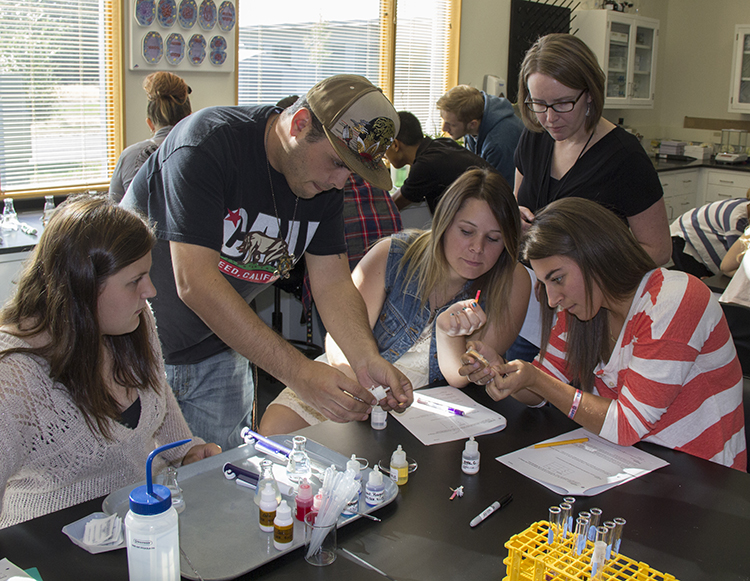April 24, 2015
 Yesterday, U.S. Deputy Secretary of Commerce Bruce Andrews signed a Cooperation Arrangement between the U.S. Department of Commerce and the European Commission’s Directorate-General for Internal Market, Industry, Entrepreneurship and SMEs (DG GROWTH). The agreement aims to makes it easier for clusters and their member businesses in the United States and the European Union to form strategic partnerships across the Atlantic.
Yesterday, U.S. Deputy Secretary of Commerce Bruce Andrews signed a Cooperation Arrangement between the U.S. Department of Commerce and the European Commission’s Directorate-General for Internal Market, Industry, Entrepreneurship and SMEs (DG GROWTH). The agreement aims to makes it easier for clusters and their member businesses in the United States and the European Union to form strategic partnerships across the Atlantic.
During the signing ceremony, Deputy Secretary Andrews highlighted the Commerce Department’s commitment to supporting regional innovation clusters to help grow our economy, create jobs, and make small and medium-sized businesses more competitive in the global marketplace. He added that the agreement with DG GROWTH is a part of Commerce’s long-standing partnership with the European Commission on initiatives to promote trade, investment and innovation on both sides of the Atlantic.
> Read more
April 2015 Newsletter
 There was a time where people who wanted to grow their own crops or buy an electric vehicle were on the fringes of society. That has all begun to change. Doing things in an environmentally friendly way has gone mainstream. Restaurants can charge top dollar for serving sustainable foods from local farms, and Tesla can charge $80,000 for an electric vehicle – and people are paying it. LEED certification for businesses and homes has become a sort of status symbol. People are rightly demanding more sustainable and eco-friendly options, and that change is reflected in economic development projects and priorities at the local and federal levels at every step along the way.
There was a time where people who wanted to grow their own crops or buy an electric vehicle were on the fringes of society. That has all begun to change. Doing things in an environmentally friendly way has gone mainstream. Restaurants can charge top dollar for serving sustainable foods from local farms, and Tesla can charge $80,000 for an electric vehicle – and people are paying it. LEED certification for businesses and homes has become a sort of status symbol. People are rightly demanding more sustainable and eco-friendly options, and that change is reflected in economic development projects and priorities at the local and federal levels at every step along the way.
The city of Austin, Texas has an ambitious zero waste goal and has undertaken a number of projects in and around the city to meet it. In July 2014, EDA awarded the city of Austin a $1 million grant to help build infrastructure for the Austin [re] Manufacturing Hub, which will allow recyclables to be transformed into new products locally. Currently, many of the recyclable items collected in the city are sent overseas for manufacturing, which uses significant resources for transportation and provides job opportunities for other countries.
> Read more
April 2015 Newsletter
By Mia Colson, National Association of Regional Councils
 As population growth continues to expand in suburban and urban areas, many neighborhoods are seeing trees and shrubs replaced by sidewalks and streets. Increased development leaves less space available for natural landscape. Inadequate vegetation reaps negative consequences for community livability. Stormwater runoff, reduced air and water quality, and infrastructure costs all become major issues when plants and trees are taken out of the picture. Green infrastructure and urban forestry projects provide cost-effective mechanisms for local governments to reduce stormwater runoff, meet environmental goals, and improve community livability.
As population growth continues to expand in suburban and urban areas, many neighborhoods are seeing trees and shrubs replaced by sidewalks and streets. Increased development leaves less space available for natural landscape. Inadequate vegetation reaps negative consequences for community livability. Stormwater runoff, reduced air and water quality, and infrastructure costs all become major issues when plants and trees are taken out of the picture. Green infrastructure and urban forestry projects provide cost-effective mechanisms for local governments to reduce stormwater runoff, meet environmental goals, and improve community livability.
Although most people think about green infrastructure for its water quality benefits, green infrastructure has numerous economic benefits, including:
- Increased Property Values: Green spaces can increase residential home values. A study in Philadelphia found that when vacant lots were retrofitted with rain gardens and other green infrastructure, surrounding home values increased by up to thirty percent.
- Reduced Infrastructure Costs: Public expenses for stormwater infrastructure are greatly reduced when relying on green infrastructure for stormwater management. Green techniques typically cost less than gray infrastructure in cities with a combined sewer system.
> Read more
April 2015 Newsletter
 With much of the west coast experiencing record droughts and even more dire predictions for the future, managing water and natural resources has become a critical priority for many communities. While there are many short-term measures that are being taken to cope with the shortage of rain and dwindling of reservoirs, there are some who recognize the need for longer term solutions. Walla Walla, Washington has been working on this issue since the late 90s. To address challenges and advance solutions, organizations in the Walla Walla Valley came together to create the William A. Grant Walla Water & Environmental Center (WEC) at Walla Walla Community College as a nexus for the region’s interests, talent and resources dedicated to water management, education and research. The Water & Environmental Center was designed as a space where education, collaboration and partnership would play a key role in addressing issues essential to the sustainability of eastern Washington’s overall economy. By combining research and development that leads to innovative new ideas, while also providing hands-on education to train new workers, the Center offers a place to both generate environmental solutions and spur economic growth that results in well-paid jobs.
With much of the west coast experiencing record droughts and even more dire predictions for the future, managing water and natural resources has become a critical priority for many communities. While there are many short-term measures that are being taken to cope with the shortage of rain and dwindling of reservoirs, there are some who recognize the need for longer term solutions. Walla Walla, Washington has been working on this issue since the late 90s. To address challenges and advance solutions, organizations in the Walla Walla Valley came together to create the William A. Grant Walla Water & Environmental Center (WEC) at Walla Walla Community College as a nexus for the region’s interests, talent and resources dedicated to water management, education and research. The Water & Environmental Center was designed as a space where education, collaboration and partnership would play a key role in addressing issues essential to the sustainability of eastern Washington’s overall economy. By combining research and development that leads to innovative new ideas, while also providing hands-on education to train new workers, the Center offers a place to both generate environmental solutions and spur economic growth that results in well-paid jobs.
Opened in 2007, the initial LEED Silver facility included offices and meeting rooms. In its first year, the Center hosted more than 200 meetings, events and conferences on water, sustainability, and environmental issues, which led to requests for additional space.
> Read more
Commerce Blog
By Assistant Secretary of Commerce for Economic Development Jay Williams
April 13, 2015
 Last week, I had the pleasure of touring Rhode Island at the invitation of the state’s congressional delegation to see first-hand the collaborative work taking place there to build the next generation of businesses for the region. I was impressed with the Ocean State’s dedicated workers and by the atmosphere of collaboration there. By working together, Rhode Island is capitalizing on its assets and innovation to ensure its global competiveness.
Last week, I had the pleasure of touring Rhode Island at the invitation of the state’s congressional delegation to see first-hand the collaborative work taking place there to build the next generation of businesses for the region. I was impressed with the Ocean State’s dedicated workers and by the atmosphere of collaboration there. By working together, Rhode Island is capitalizing on its assets and innovation to ensure its global competiveness.
The Economic Development Administration (EDA) has been, and will continue to be, a proud partner in Rhode Island in advancing American innovation and entrepreneurship.
> Read more
Commerce Blog
April 2, 2015
 Because of the hard work our communities and regions, our Nation has roared back from a great recession. We have transformed from a struggling economy in which 8 million jobs were lost to a powerful economy that has created 12 million new jobs over the past 60 months.
Because of the hard work our communities and regions, our Nation has roared back from a great recession. We have transformed from a struggling economy in which 8 million jobs were lost to a powerful economy that has created 12 million new jobs over the past 60 months.
While there are many success stories to point to across the Nation, some communities experience setbacks that cannot be anticipated or prevented. Natural disasters – for example - do more than wipe out homes; they can wipe out businesses and decimate local economies. That’s why EDA’s regional offices work with communities to help them prepare for and rebound from the economic impact of natural disasters.
> Read more
 Yesterday, U.S. Deputy Secretary of Commerce Bruce Andrews signed a Cooperation Arrangement between the U.S. Department of Commerce and the European Commission’s Directorate-General for Internal Market, Industry, Entrepreneurship and SMEs (DG GROWTH). The agreement aims to makes it easier for clusters and their member businesses in the United States and the European Union to form strategic partnerships across the Atlantic.
Yesterday, U.S. Deputy Secretary of Commerce Bruce Andrews signed a Cooperation Arrangement between the U.S. Department of Commerce and the European Commission’s Directorate-General for Internal Market, Industry, Entrepreneurship and SMEs (DG GROWTH). The agreement aims to makes it easier for clusters and their member businesses in the United States and the European Union to form strategic partnerships across the Atlantic.


 There was a time where people who wanted to grow their own crops or buy an electric vehicle were on the fringes of society. That has all begun to change. Doing things in an environmentally friendly way has gone mainstream. Restaurants can charge top dollar for serving sustainable foods from local farms, and Tesla can charge $80,000 for an electric vehicle – and people are paying it. LEED certification for businesses and homes has become a sort of status symbol. People are rightly demanding more sustainable and eco-friendly options, and that change is reflected in economic development projects and priorities at the local and federal levels at every step along the way.
There was a time where people who wanted to grow their own crops or buy an electric vehicle were on the fringes of society. That has all begun to change. Doing things in an environmentally friendly way has gone mainstream. Restaurants can charge top dollar for serving sustainable foods from local farms, and Tesla can charge $80,000 for an electric vehicle – and people are paying it. LEED certification for businesses and homes has become a sort of status symbol. People are rightly demanding more sustainable and eco-friendly options, and that change is reflected in economic development projects and priorities at the local and federal levels at every step along the way. As population growth continues to expand in suburban and urban areas, many neighborhoods are seeing trees and shrubs replaced by sidewalks and streets. Increased development leaves less space available for natural landscape. Inadequate vegetation reaps negative consequences for community livability. Stormwater runoff, reduced air and water quality, and infrastructure costs all become major issues when plants and trees are taken out of the picture. Green infrastructure and urban forestry projects provide cost-effective mechanisms for local governments to reduce stormwater runoff, meet environmental goals, and improve community livability.
As population growth continues to expand in suburban and urban areas, many neighborhoods are seeing trees and shrubs replaced by sidewalks and streets. Increased development leaves less space available for natural landscape. Inadequate vegetation reaps negative consequences for community livability. Stormwater runoff, reduced air and water quality, and infrastructure costs all become major issues when plants and trees are taken out of the picture. Green infrastructure and urban forestry projects provide cost-effective mechanisms for local governments to reduce stormwater runoff, meet environmental goals, and improve community livability.  With much of the west coast experiencing
With much of the west coast experiencing  Last week, I had the pleasure of touring Rhode Island at the invitation of the state’s congressional delegation to see first-hand the collaborative work taking place there to build the next generation of businesses for the region. I was impressed with the Ocean State’s dedicated workers and by the atmosphere of collaboration there. By working together, Rhode Island is capitalizing on its assets and innovation to ensure its global competiveness.
Last week, I had the pleasure of touring Rhode Island at the invitation of the state’s congressional delegation to see first-hand the collaborative work taking place there to build the next generation of businesses for the region. I was impressed with the Ocean State’s dedicated workers and by the atmosphere of collaboration there. By working together, Rhode Island is capitalizing on its assets and innovation to ensure its global competiveness.  Because of the hard work our communities and regions, our Nation has roared back from a great recession. We have transformed from a struggling economy in which 8 million jobs were lost to a powerful economy that has created 12 million new jobs over the past 60 months.
Because of the hard work our communities and regions, our Nation has roared back from a great recession. We have transformed from a struggling economy in which 8 million jobs were lost to a powerful economy that has created 12 million new jobs over the past 60 months.